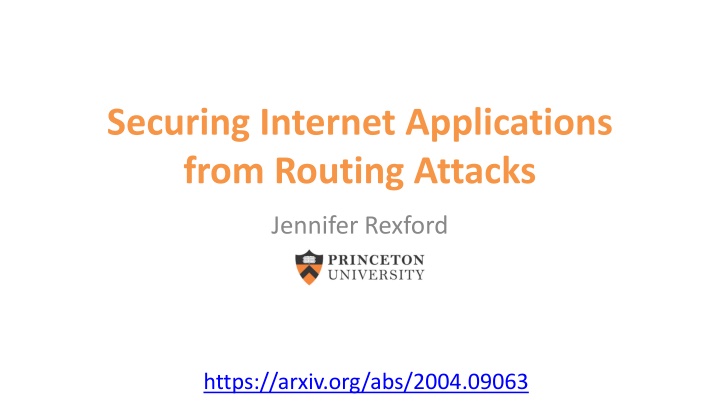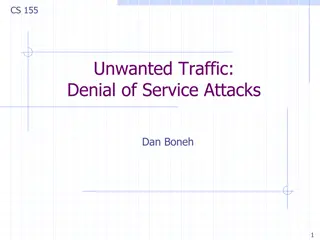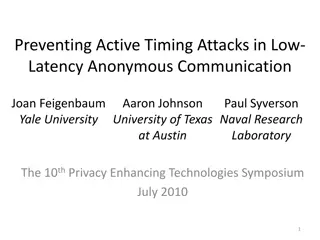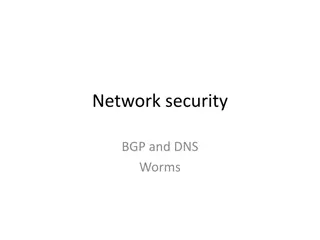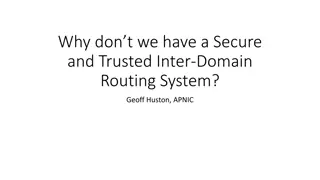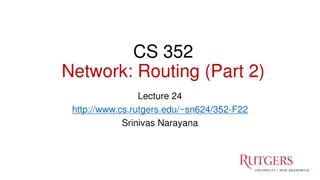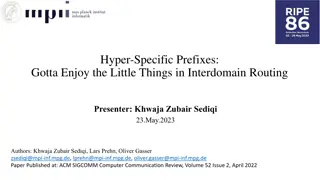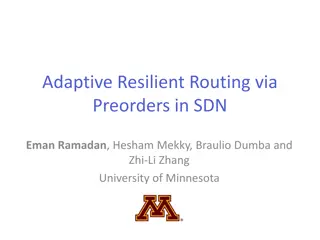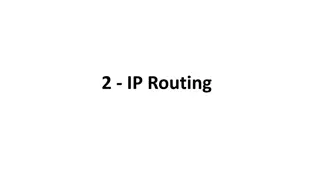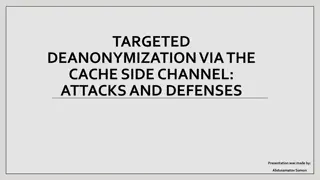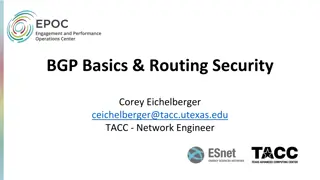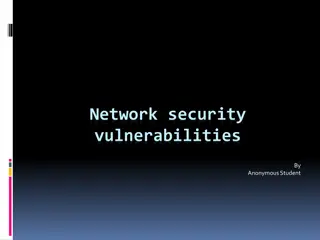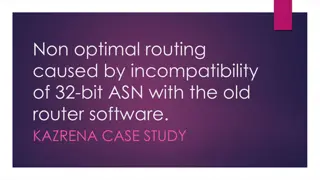Securing Internet Applications from Routing Attacks
This document explores the vulnerabilities in Border Gateway Protocol (BGP) and the impact on interdomain routing security, highlighting the importance of securing internet applications from routing attacks. It discusses issues like simple BGP prefix hijacks, sub-prefix hijacks, forged origin AS, path poisoning, and targeted, stealthy attacks on specific senders.
Download Presentation

Please find below an Image/Link to download the presentation.
The content on the website is provided AS IS for your information and personal use only. It may not be sold, licensed, or shared on other websites without obtaining consent from the author.If you encounter any issues during the download, it is possible that the publisher has removed the file from their server.
You are allowed to download the files provided on this website for personal or commercial use, subject to the condition that they are used lawfully. All files are the property of their respective owners.
The content on the website is provided AS IS for your information and personal use only. It may not be sold, licensed, or shared on other websites without obtaining consent from the author.
E N D
Presentation Transcript
Securing Internet Applications from Routing Attacks Jennifer Rexford https://arxiv.org/abs/2004.09063
Interdomain Routing Security Border Gateway Protocol (BGP) Vulnerable to attack and misconfiguration Attacks affecting availability and confidentiality Yet, deploying BGP security solutions is hard 1
Application Security Security-sensitive applications Use cryptography to protect end users Rely on the underlying network to deliver data Treat the network as a dumb pipe but should they? 2
Simple BGP Prefix Hijack 4 3 5 2 6 7 1 12.34.0.0/16 12.34.0.0/16: (1) 4
Sub-Prefix Hijack 4 3 5 2 6 7 1 12.34.0.0/16 12.34.158.0/24: (1) 5
Forged Origin AS 4 3 5 2 6 7 1 12.34.0.0/16 12.34.0.0/16: (1 6) Forged origin AS! 6
Path Poisoning 4 3 5 2 6 7 1 12.34.0.0/16 12.34.0.0/16: (1 3) Trigger AS loop detection at AS 3! 7
Stealthy, Targeted Attacks Targeted senders Specific sender Easiest sender to attack of a group Limited scope Limit the other ASes that see the hijack Limit the data traffic that follows the hijack path Limited time Short interval of time During a sensitive event 8
Surgical Hijack 1 5 6 2 8 7 3 12.34.0.0/16 12.34.0.0/16: (4 5 6 7 8) 9 4 9
Stealthy, Targeted Attacks Targeted sender Specific sender (e.g., a specific certificate authority) Easiest sender to attack of a group (e.g., any certificate authority) Limited scope Limit the other ASes that see the hijack Limit the data traffic that follows the hijack path Limited time Short interval of time During a sensitive event (e.g., acquiring a certificate) Henry Birge-Lee, Yixin Sun, Annie Edmundson, Jennifer Rexford, and Prateek Mittal, "Bamboozling certificate authorities with BGP," in USENIX Security, August 2018. 10
CA Domain Control Verification Hijack here! 1. Certificate signing request 4. GET example.com/verify.html 5. HTTP response 2. Domain control verification request 3. Server modification 11
Launching Ethical Attacks Attacking ourselves IP prefix we control (PEERING testbed) Domain names created for the experiment No real clients accessing the server Bamboozling the certificate authorities Let s Encrypt, GoDaddy, Comodo, Symantec, GlobalSign Domain validation using either HTTP request or email All five CAs signed our certificate requests 12
Application-Level Defense You can fool some of the people some of the time But not all of the people all of the time Multiple vantage point domain verification Deployed by Let s Encrypt Starting February 2020 13
BGP Interception Attack 4 3 5 12.34.0.0/16: (3 2) 6 7 2 12.34.0.0/16 14
Targeted Attack Adversary needs to be on two paths Between client and entry Between exit and server In either direction Seeing data packets Or, seeing the TCP ACKs BGP interception attacks To force the traffic to traverse the adversary Yixin Sun, Anne Edmundson, Laurent Vanbever, Oscar Li, Jennifer Rexford, Mung Chiang, and Prateek Mittal, "RAPTOR: Routing Attacks on Privacy in Tor," in USENIX Security, August 2015. 17
Launching Ethical Attacks Tor entry we control Ran our own Tor entry (guard) node Using an IP prefix we control (PEERING testbed) Tor clients we control PlanetLab clients use our entry node Download 100 MB objects from web servers we control Launch interception attack Intercept client-to-entry traffic Perform timing analysis attack Successful in deanonymizing 18
Application-Level Defenses Clients: AS-aware path selection Tor network monitors BGP path dynamics Distribute AS-PATH data to Tor clients Clients avoid Tor paths traversing the same AS twice Tor: mitigating routing attacks Using /24 prefixes for Tor nodes (prevent subprefix interception) Detecting BGP routing changes and notifying Tor clients 19
More Applications Domain verification Changing an account password Verifying ownership of a restaurant, hotel, etc. Anonymous communication Other anonymous communication systems E.g., I2P and VPNs Bitcoin network Disrupting the consensus protocol in the overlay network 20
Conclusion Cross-layer attacks Layering simplifies protocol design But, adversaries can work across layer boundaries Cross-layer defenses Application-layer defenses are easier to deploy But, network-layer defenses are still important A way forward Protect popular applications Protect important IP prefixes Incentivize BGP security by favoring secure prefixes and ASes https://arxiv.org/abs/2004.09063 21
